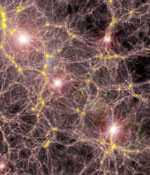
Image source: CfA
According to cosmologists, the early Universe only had a mixture of hydrogen, helium and other lighter elements, but none of the heaver elements required for life – like carbon. From the original gasses, giant stars formed – some were 200 times larger than our Sun – lived for a brief time, often just a few million years. These giant stars converted up to 50% of their material into heaver elements, mostly iron, before exploding violently as supernovae. The James Webb telescope, due for launch after 2011 will be so sensitive it should be able to look back to watch these supernovae happening.
The early universe was a barren wasteland of hydrogen, helium, and a touch of lithium, containing none of the elements necessary for life as we know it. From those primordial gases were born giant stars 200 times as massive as the Sun, burning their fuel at such a prodigious rate that they lived for only about 3 million years before exploding. Those explosions spewed elements like carbon, oxygen and iron into the void at tremendous speeds. New simulations by astrophysicists Volker Bromm (Harvard-Smithsonian Center for Astrophysics), Naoki Yoshida (National Astronomical Observatory of Japan) and Lars Hernquist (CfA) show that the first, “greatest generation” of stars spread incredible amounts of such heavy elements across thousands of light-years of space, thereby seeding the cosmos with the stuff of life.
This research is posted online at http://arxiv.org/abs/astro-ph/0305333 and will be published in an upcoming issue of The Astrophysical Journal Letters.
“We were surprised by how violent the first supernova explosions were,” says Bromm. “A universe that was in a pristine state of tranquility was rapidly and irreversibly transformed by a colossal input of energy and heavy elements, setting the stage for the long cosmic evolution that eventually led to life and intelligent beings like us.”
Approximately 200 million years after the Big Bang, the universe underwent a dramatic burst of star formation. Those first stars were massive and fast-burning, quickly fusing their hydrogen fuel into heavier elements like carbon and oxygen. Nearing the end of their lives, desperate for energy, those stars burned carbon and oxygen to form heavier and heavier elements until reaching the end of the line with iron. Since iron cannot be fused to create energy, the first stars then exploded as supernovae, blasting the elements that they had formed into space.
Each of those first giant stars converted about half of its mass into heavy elements, much of it iron. As a result, each supernova hurled up to 100 solar masses of iron into the interstellar medium. The death throes of each star added to the interstellar bounty. Hence, by the remarkably young age of 275 million years, the universe was substantially seeded with metals.
That seeding process was aided by the structure of the infant universe, where small protogalaxies less than one-millionth the mass of the Milky Way crammed together like people on a crowded subway car. The small sizes of and distances between those protogalaxies allowed an individual supernova to rapidly seed a significant volume of space.
Supercomputer simulations by Bromm, Yoshida, and Hernquist showed that the most energetic supernova explosions sent out shock waves that flung heavy elements up to 3,000 light-years away. Those shock waves swept huge amounts of gas into intergalactic space, leaving behind hot “bubbles,” and triggered new rounds of star formation.
Supernova expert Robert Kirshner (CfA) says, “Today this is a fascinating theory, based on our best understanding of how the first stars worked. In a few years, when we build the James Webb Space Telescope, the successor to the Hubble Space Telescope, we should be able to see these first supernovae and test Volker’s ideas. Stay tuned!”
Lars Hernquist notes that the second generation of stars contained heavy elements from the first generation – seeds from which rocky planets like Earth could grow. “Without that first, ‘greatest generation’ of stars, our world would not exist.”
Headquartered in Cambridge, Mass., the Harvard-Smithsonian Center for Astrophysics is a joint collaboration between the Smithsonian Astrophysical Observatory and the Harvard College Observatory. CfA scientists, organized into six research divisions, study the origin, evolution and ultimate fate of the universe.
Original Source: CfA News Release
